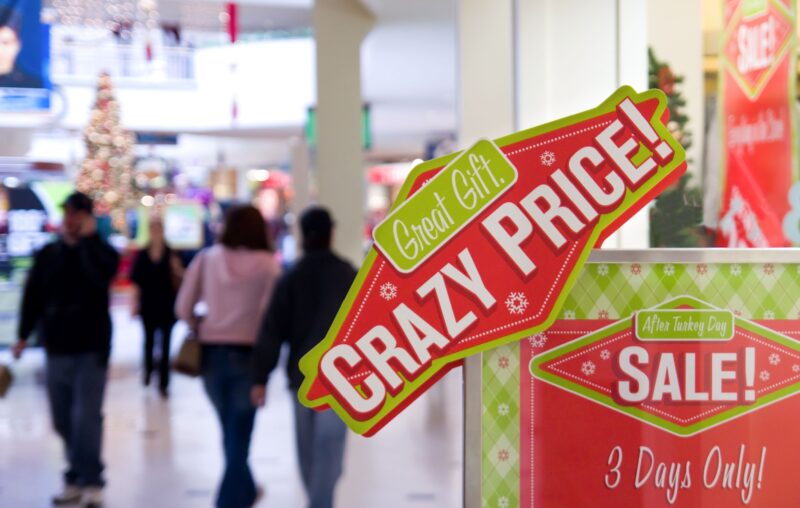


Black Friday was once a sure bet that consumers would engage in a shopping frenzy. But it felt different in 2023, and the data tell us why. Years of rampant inflation had tempered consumer spending expectations for the 2023 event. Did inflation ruin Black Friday? It certainly did its best to spoil the party, but ultimately, markets prevailed.
Monetary and fiscal policy drove inflation over the past three years, putting pressure on business budgets and raising consumer prices. From March 2020 to Black Friday (Nov. 24) 2023, the Federal Reserve’s total assets (the balance sheet) increased from roughly $4.2 to $8 trillion, a historically high increase of nearly 50 percent. Fiscal policy played its part: federal spending increased the national debt by 89 percent since 2020, racking up nearly $9 trillion in deficits in three years.
This rapid increase in the money supply and record government spending helped drive most price indices, including both labor and non-labor input costs for businesses. Higher input costs translate to higher consumer prices. Tracking a basket of common Black Friday goods, AIER economist Peter Earle estimated a 12.53-percent price increase since 2019. In other words, $2,000 worth of goods in 2020 would cost $2,218.89 today.
This upward price pressure created speculation that business margins would be squeezed too thin to offer seasonal discounts consumers expect. But data from WalletHub show that in 2023, retailer discounts matched or exceeded those seen in 2022. WalletHub averaged eight years of Black Friday discounts, and the annual markdown has been roughly 36 percent. Retailers matched that average in 2023, at 35 percent, with some product markdowns as high as 59 percent discounts. An alternative but agreeing survey estimates that average discounts were 31 percent in 2023, up from 25 percent in 2022.
Despite all the speculation, Black Friday 2023 was a success. Consumers spent a record $9.8 trillion, a 7.5 percent increase over 2022. While good discounts are the core of Black Friday and drive most of the sales, myriad factors impact consumer spending during the season.
Black Friday has evolved from a one-day event into a multi-month discount period. Extended discounts benefit consumers by allowing them to take advantage of sales and generating price competition among retailers. But despite the feeling that this makes Black Friday less “special”, it hasn’t dampened overall spending, just shifted it around.
CNBC reports that October had deeper discounts and 6 percent more sales than the previous year. Another survey showed half of Americans made purchases on pre-Thanksgiving sales, 24 percent more than in 2022.
Amazon’s “Prime Day” in July also provides a mid-season opportunity to get discounts, creating competition and price pressure on traditional Black Friday outlets. Now Target, Walmart, and Best Buy all offer “Black Friday in July” sales, further depressing prices throughout the year and making doorbuster sales seem less impressive. The doorbuster model of Black Friday may have created a psychological effect where consumers see deals as more exclusive and deeply discounted, but data show that the longer period of discounts contributes to overall higher spending. We might save more, but we’re spending more, too.
Black Friday and consumer spending have also shifted online. Adobe Analytics reports that a record-high $5.3 billion was spent from mobile phones, representing half of total online sales. Improved online experience, faster shipping, and the convenience of shopping at home are cited as reasons for the shift. While these may detract from the traditional “feel” of Black Friday, lessening crowds around department store doors, spending data show customers prefer to stay home.
Another factor in Black Friday’s success was consumer debt spending. While the Federal Reserve has slightly reversed course by shrinking its balance sheet in the past 9-12 months, and inflation has leveled off in terms of relative growth, the inflationary damage has been done. Despite all the discounts that Black Friday provides, prices are still much higher than they were two years ago, and consumers are using debt to cover the gap. Black Friday consumer credit spending increased by 47 percent year-over-year, mirroring an overall increase in credit usage. A record $1.3 trillion in credit card debt may be masking a weaker economy than the top-line spending numbers suggest, as consumers accrue debt to maintain a standard of living being crushed by rising prices in housing, groceries, and energy.
Yet Black Friday’s discounts are as deep as they ever were, offered at more time periods, and consumers keep spending, online if not in stores. Producers continue to make the things Americans want to buy for themselves and each other at gifting time. Retailers make the buying experience convenient and attractive to consumers, and offer discounts that customers happily seize, and they never have to leave home to do it.
These market innovations continue to drive a strong economy despite the burden of inflation that squeezes the joy out of seasonal shopping, and eats up our everyday budgets. Black Friday remains a wildly successful phenomenon of market competition even in the era of historic inflation and could be even bigger without it.




